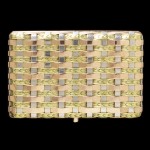 The The Victoria and Albert Museum (V&A) is the proud new owner of nine exceptional works by Carl Fabergé donated by the son of the late Kenneth Snowman, one of the world’s most prominent Fabergé experts. Two rare works by 18th century goldsmith Johann Christian Neuber were also part of the donation. Nicholas Snowman donated the pieces in the Kenneth and Sallie Snowman Collection under the Cultural Gifts Scheme, a program that allows the donation of significant cultural heritage objects in exchange for tax savings in the amount of 30% of their market value, in this case a discount of £615,000 ($772,000).
The The Victoria and Albert Museum (V&A) is the proud new owner of nine exceptional works by Carl Fabergé donated by the son of the late Kenneth Snowman, one of the world’s most prominent Fabergé experts. Two rare works by 18th century goldsmith Johann Christian Neuber were also part of the donation. Nicholas Snowman donated the pieces in the Kenneth and Sallie Snowman Collection under the Cultural Gifts Scheme, a program that allows the donation of significant cultural heritage objects in exchange for tax savings in the amount of 30% of their market value, in this case a discount of £615,000 ($772,000).
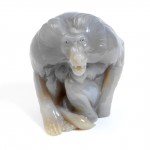 The Fabergé pieces in the donation include four animals masterfully carved out of chalcedony and agate for Queen Alexandra, wife of King Edward VII and Tsar Nicholas II’s aunt, herself an accomplished wood carver. Alexandra’s Fabergé animals are a hissing baboon, a sturgeon, a kangaroo and a chinchilla. Other animals in the collection include a seal carved out of obsidian with such dazzling attention to detail that the skin texture is perfectly matched to the stone, and a quartz hare inspired by Japanese netsuke. One of the objects, a rock crystal letter opener, has a moving sentimental connection to
The Fabergé pieces in the donation include four animals masterfully carved out of chalcedony and agate for Queen Alexandra, wife of King Edward VII and Tsar Nicholas II’s aunt, herself an accomplished wood carver. Alexandra’s Fabergé animals are a hissing baboon, a sturgeon, a kangaroo and a chinchilla. Other animals in the collection include a seal carved out of obsidian with such dazzling attention to detail that the skin texture is perfectly matched to the stone, and a quartz hare inspired by Japanese netsuke. One of the objects, a rock crystal letter opener, has a moving sentimental connection to 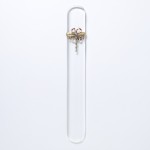 the last of the Romanovs. It was a present given by Tsarina Alexandra to her onetime English governess, Miss Jackson, for Christmas in 1900. Miss Jackson had become a surrogate mother for Alexandra after her own mother died from diphtheria, contracted during her tireless nursing of her entire family when they were stricken by the disease. Alexandra was just six years old when her mother died, so Miss Jackson provided much-needed support to the bereft child.
the last of the Romanovs. It was a present given by Tsarina Alexandra to her onetime English governess, Miss Jackson, for Christmas in 1900. Miss Jackson had become a surrogate mother for Alexandra after her own mother died from diphtheria, contracted during her tireless nursing of her entire family when they were stricken by the disease. Alexandra was just six years old when her mother died, so Miss Jackson provided much-needed support to the bereft child.
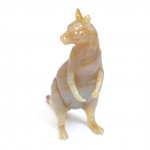 Kenneth Snowman is a Fabergé legend. The son of jeweller Emanuel Snowman and Harriet Wartski, daughter of Morris Wartski, founder of the Wartski company which, thanks to Emanuel’s buying trips to the Soviet Union in the 20s and 30s when Fabergé had dropped out of cultural consciousness, became the leading dealers and experts in Fabergé’s exquisite Imperial Eggs and the many jeweled and enamelled treasures he made for the aristocracy of pre-Revolutionary Russia. Born in 1919, as a child Kenneth played with
Kenneth Snowman is a Fabergé legend. The son of jeweller Emanuel Snowman and Harriet Wartski, daughter of Morris Wartski, founder of the Wartski company which, thanks to Emanuel’s buying trips to the Soviet Union in the 20s and 30s when Fabergé had dropped out of cultural consciousness, became the leading dealers and experts in Fabergé’s exquisite Imperial Eggs and the many jeweled and enamelled treasures he made for the aristocracy of pre-Revolutionary Russia. Born in 1919, as a child Kenneth played with 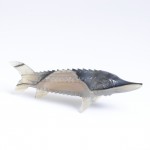 some of the nine Imperial Eggs his father brought home from the Soviet Union. Little wonder, then, that as an adult he become a published Fabergé scholar, curator and world-renowned expert. When his father-in-law died, he became chairman of Wartski, which you might recall played an integral role in the stranger-than-fiction saga of the lost Imperial Egg found by a scrap metal dealer in the US midwest.
some of the nine Imperial Eggs his father brought home from the Soviet Union. Little wonder, then, that as an adult he become a published Fabergé scholar, curator and world-renowned expert. When his father-in-law died, he became chairman of Wartski, which you might recall played an integral role in the stranger-than-fiction saga of the lost Imperial Egg found by a scrap metal dealer in the US midwest.
Nicholas Snowman’s choice of the V&A was a tribute to his father’s deep bonds with the institution.
The donor, Nicholas Snowman, son of Kenneth, said: “In 1977 my father curated a major Fabergé exhibition at the Victoria and Albert Museum to honour the Queen’s Silver Jubilee. He was devoted to the V&A.”
He said following the latest donation the V&A now “possesses the most significant public collection of Fabergé in Britain and its important collection of gold boxes has been enriched enormously.”
Tristram Hunt, director of the Victoria & Albert Museum, said: “Nicholas Snowman’s Cultural Gift is the most important donation of Fabergé ever made to a British public collection and will greatly enrich the V&A’s jewellery holdings. It is an act of great generosity and cultural philanthropy.”
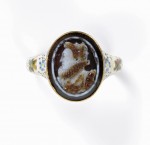 Underscoring the generosity of the act is a 13th object Nicholas Snowman donated to the V&A, only he didn’t do it directly. He deliberately donated a 16th century cameo portrait of Elizabeth I later mounted on a ring to the Art Fund who then (by arrangement) donated it to the V&A. He did this in recognition of the Art Fund’s hugely successful campaign to acquire the Armada Portrait for the Royal Museums Greenwich.
Underscoring the generosity of the act is a 13th object Nicholas Snowman donated to the V&A, only he didn’t do it directly. He deliberately donated a 16th century cameo portrait of Elizabeth I later mounted on a ring to the Art Fund who then (by arrangement) donated it to the V&A. He did this in recognition of the Art Fund’s hugely successful campaign to acquire the Armada Portrait for the Royal Museums Greenwich.
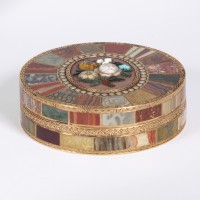
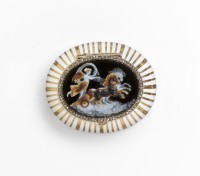
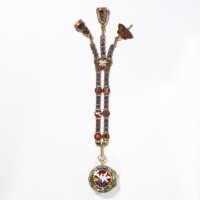
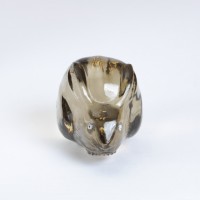
 
Beautiful pieces, as are all his work. His grand-daughter Tatiana Fabergé is my fourth cousin. She lives in France, just over the border from Geneva (where I live).
How cool! I understand Tatiana was interviewed for a recent Fabergé documentary which is being released on Blu-Ray, DVD and iTunes on April 10th. It’s on YouTube already, but I’m pretty sure it’s not supposed to be so that may or may not last.
Is ‘Vierotchka’ the Russian short form of ‘Veronica’ :confused: ? – Cheers
I think Queen Alexandra was the wife of King Edward VII. Wasn’t Edward VIII her grandson?
Gah, yes! Although he did have several things in common with Edward VII, namely a taste for women of questionable repute. Thank you for the typo alert. :thanks:
No, it is one of the diminutives for Vera. 🙂
Kenneth Snowman played with them as a child? Either he was the best-behaved child ever, or his parents were extremely calm people.
I think it’s wonderful that these are going to an institution where they’ll be seen, rather than to a private collection.
Wow. They are all so gorgeous. What an amazing artist.
Wartski and the Snowmans are absolute heroes of mine. Queen Victoria’s Sapphire and Diamond Tiara was lent to the Wartski business for the 1997 exhibition. The second exhibition of tiaras, which I actually saw, was held at the Victoria Albert Museum in 2002. It too was organised by Wartski’s.
I did not know that. Note that, since her mother died, we haven’t had much contact at all, to my regret. We are related through her mother’s family. I look forward to watching that interview. Thanks for the info. 🙂
Veronica is a female given name, the Latin transliteration of the Greek name Berenice, Βερενίκη.[1] This was the Macedonian form of the Athenian Φερενίκη, Phereníkē, or Φερονίκη, Pheroníkē, from φέρειν, phérein, to bring, and νίκη, níkê, “victory”, i.e. “she who brings victory”.The Ancient Macedonian form of the name was popularized because of its extensive use as a royal feminine name by the reigning dynasties of the states of the Diadochi of Alexander the Great throughout the Eastern Mediterranean during the Hellenistic age, most notably by the Ptolemies of Egypt and by the Seleucids of Asia.
In medieval etymology, Veronica was sometimes wrongly supposed to derive from Latin vera (true) and Greek eikon (image).[4] Its popularity in medieval and modern times is based mainly on the importance in Christianity of Saint Veronica and her Veil of Veronica.
Pet forms of Veronica include Ronnie and Roni and the German Frony, as well as Vicki. In Russian, the pet form is Nika (Ника).
Vera is a female first name of Slavic origin meaning faith, or of Latin origin meaning true. Usage: Russian, English, German, Greek, Hungarian, Slovak, Czech, Scandinavian, Dutch, Slovene, Bulgarian, Serbian, Croatian, Macedonian, Portuguese, Spanish, Albanian, French, Polish, Romanian, Italian.
~From Wikipedia
Why I included this is because up to this point I believed the medieval etymology!
Vera in Russian and all the other slavic languages does not mean true, it means faith.
Sorry, my tired eyes misread you. 🙂
Would then верование mean ‘orthodox’ ? (orthos=true/vera and doxa=faith), thus, is вера its ‘short form’ ? :thanks:
——
BTW – “In 811 AD, Nikephoros I (=the male form of ‘veronika’) invaded Bulgaria, defeated Krum (Khan of Bulgaria) twice, and sacked the Bulgarian capital Pliska. However, during Nikephoros’ retreat, the Byzantine army was ambushed and destroyed in Varbishki mountain passes on July 26 by Krum. Nikephoros was captured during the battle and sent to Pliska, where Krum ordered his decapitation. Krum is said to have made a drinking-cup of Nikephoros’ skull.”
Orthodox is Православный (Pravoslavnyi). 🙂
Верование (verovaniye) means belief. Вера (Vera) means faith.
Faith and Belief Are Not the Same
🙂
Thank You. Indeed, these things are probably not ‘bijective’ (as Google customers should know), i.e. they won’t work in both directions and, additionally, sometimes items do have several denominations, while others even have ‘doubled’ ones.
As I don’t speak Russian at all and my English is broken, I already had found Православный (Pravoslavnyi), while my source provided me with Верование (verovaniye) and Вера (Vera) as synonyms, what they indeed not necessarily are. In addition to faith and belief, there is ‘power’ and ‘force’ (or whatever they might call it, “cuius regio, eius religio” – or the other way round ?).
What I could not figure out -and my source had no solution for- is what the -вание (-vaniye) bit could stand for. ‘Zoega’s Old Icelandic dictionary’ gives ‘vandi‘ as ‘custom’ or ‘habit’, but also as ‘difficulty’ 😆 – δόξα (grk., ‘Doxa’) is (sometimes) ‘expectation’.